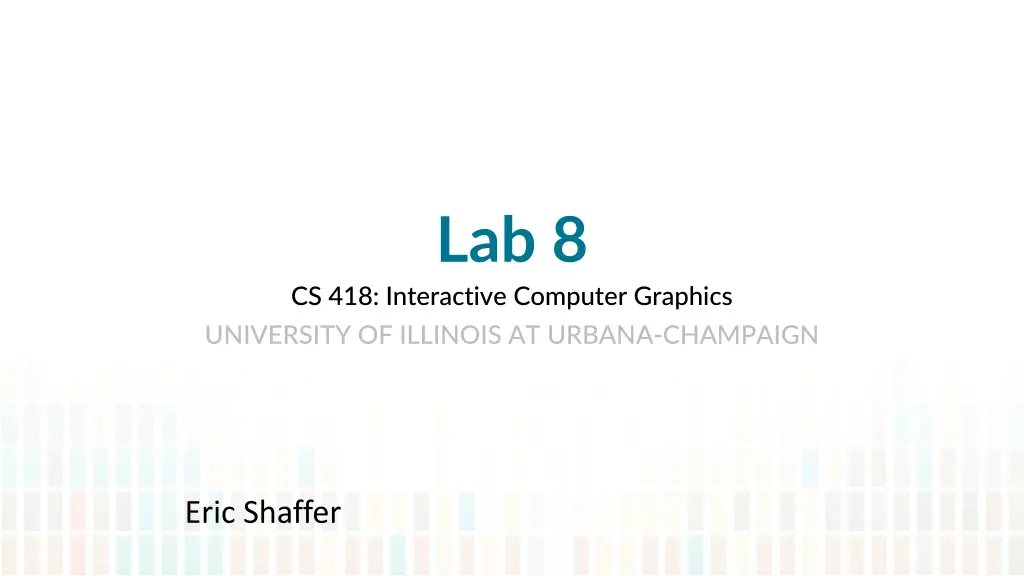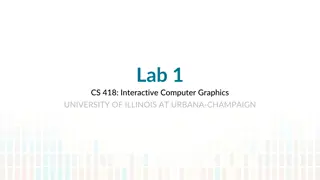
Implementing Mesh File Parser for 3D Graphics with Asynchronous File Reading
Learn how to implement a mesh file parser for 3D graphics in a lab project at University of Illinois at Urbana-Champaign. Discover the process of asynchronously fetching and rendering a server-side OBJ file, handling asynchronous events, and setting up a local server for testing. Utilize JavaScript to parse OBJ text files and populate vertex and face buffers for the mesh, all of which will be used in a larger project.
Uploaded on | 1 Views
Download Presentation

Please find below an Image/Link to download the presentation.
The content on the website is provided AS IS for your information and personal use only. It may not be sold, licensed, or shared on other websites without obtaining consent from the author. If you encounter any issues during the download, it is possible that the publisher has removed the file from their server.
You are allowed to download the files provided on this website for personal or commercial use, subject to the condition that they are used lawfully. All files are the property of their respective owners.
The content on the website is provided AS IS for your information and personal use only. It may not be sold, licensed, or shared on other websites without obtaining consent from the author.
E N D
Presentation Transcript
Lab 8 CS 418: Interactive Computer Graphics UNIVERSITY OF ILLINOIS AT URBANA-CHAMPAIGN Eric Shaffer
Goals In this lab you will implement code to read a mesh from an OBJ file Things you will need to do include: Learn how to asynchronously fetch a server side file Handle a asynchronous event So you don t try to draw before you have the mesh ready Parse the OBJ text file using JavaScript So you can populate the vertex and face buffers for the mesh All of this code will be used in MP3
OBJ File Format It is a text (ASCII) file format for 3D surface models You will implement a parser for a subset of the format and render a cow For details on the file format: https://en.wikipedia.org/wiki/Wavefront_.obj_file
Asynchronously Read a File It would probably be more useful to read and render a file on the client side but for this MP, grading will be e easier if we read a server side file To start, we need to be able to read a text file We will write code to fetch an obj file kept on the server side The only slightly tricky part is that the fetch is done asynchronously Since the file read is asynchronous We need to not try to draw the mesh before the data is ready
Running a Local Server To avoid browser security issues, you ll need to run a local server to serve the files to the browser If you use the Brackets editor, the live preview function will start up a server (and browser) to test your code. Just have Chrome open, and the open your html file in Brackets. Click the lightning bolt icon in the top right of the Brackets window. Alternatively, you can install node.js Then install and run httpserver to serve the directory that it is run from. This can also be done using Python. Run this command in your terminal in the directory you want to serve: "python -m http.server 8000" (server number doesn't have to be 8000) Then point your browser to "localhost:8000"
function setupMesh(filename) To get the text asynchronously from the server we will use a JavaScript promise You can read about them: https://developer.mozilla.org/en-US/docs/Web/JavaScript/Guide/Using_promises
function asyncGetFile(url) in HelloMesh.js Add this code:
Function setupMesh in HelloMesh.js Now use that asyncGetFile function you wrote to fetch the cow.obj file and give it to the TriMesh object to be parsed
function draw() in HelloMesh.js Stop myMesh from being drawn before it is ready add an if statement to prevent this Which TriMesh function will be useful?
loadFromOBJ(fileText) in TriMesh.js Finally write code to parse the text file .
Parsing the OBJ File You just need to parse a subset of the OBJ file format Lines starting with # are comments log these to the console Lines staring with v are vertex coordinates Lines starting with f are triangles NOTE..obj vertex indices start at 1 you need to subtract one if your arrays will start at 0 To make things easier, assume faces have only 3 numbers in each record not true for full OBJ format Read those lines and fill this.vBuffer and this.fBuffer
Useful JS functions String method split() https://developer.mozilla.org/en-US/docs/Web/JavaScript/Reference/Global_Objects/String/split parseFloat https://developer.mozilla.org/en-US/docs/Web/JavaScript/Reference/Global_Objects/parseFloat parseInt https://developer.mozilla.org/en-US/docs/Web/JavaScript/Reference/Global_Objects/parseInt

